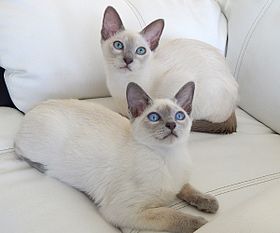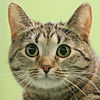Tonkanese
| Tonkanese | |
|---|---|

|
|
| Standard GCCF: TOS, CFA: TON, TICA: TO, FIFe not recognized | |
| Weight | Male: 4–5 kg female: 3–4 kg |
| allowed colors | brown blue chocolate lilac red cream and the corresponding torties |
| permitted coat drawing | all basic colors in mink, point and solid, also tabby |
| Eye color | from dark blue (point) to aquamarine (mink) to green-yellow (solid) |
| List of cat breeds | |
The Tonkanese cat breed combines characteristics of the Siamese and Burmese in a medium-sized cat with turquoise blue eyes.
history
Manuscripts from the 14th century from Ayuttaya (from 1351 to 1767 the capital of Siam, today's Thailand) show pictures of so-called copper cats (“maeo thong daeng”), pale brown animals with dark markings - amazingly similar to the Tonkanese.
It can therefore also be assumed that the Tonkanese were among the first Siamese who came to Great Britain towards the end of the 18th century. In fact, a distinction was made between the "Royal Cat of Siam" (royal cat of Siam), which had dark markings (points) and a lighter body, and the so-called "Chocolate Siamese". The latter were probably Tonkanese. Their badges were (and are still today) strongly colored, but the contrast between body and badge color (points) is very weak. The body color itself is a mixture between the hue of Burma and the body color of Siamese.
Although darker colored masked cats have been described again and again in England since 1800, the real story of the Tonkanese begins in 1930, when the American ship's doctor Dr. Joseph Thompson brought a small brown masked cat named Wong Mau back to California from one of his trips. The cat was described as a brown hybrid with darker points on the face, legs, paws and tail. She was thought to be a Siamese cat of poor color and was mated to a Siamese cat. In the litter there were lighter kittens with Siamese markings and darker ones that looked like the mother. One of the darker males was then mated back to his mother. In this litter there were young animals in three different color types: light kittens with dark mask (pointed / Siamese drawing) with deep blue eyes, dark kittens with barely visible mask (solid / Burmese colored) with yellowish-green eyes and kittens with a medium contrast (mink) and aqua colored eyes. The breeders then concentrated on the dark kittens that made Burma and neglected the cats with the medium contrast, the Tonkanese offspring. Wong Mau is considered to be the ancestral mother of the Burmese, although she was actually "Tonkanese".
It was not until 1950 that the New York breeder Milan Greer started breeding Tonkanese. But he rarely showed them at exhibitions, so that the cat scene did not begin to show any serious interest in them. In the 1960s, two breeders in the USA and Canada began to breed Siamese with Burmese. The offspring from these matings had a warm brown color with darker markings. Since the fur of the kittens reminded the breeders of a mink, they called the color "natural mink" (mink). So "Mink" became the name for the Tonkanesen drawing. This was the origin of the Tonkanese's triumphant advance throughout the English-speaking world.
The first Tonkanese were registered in Canada. In the 1970s they really came into fashion. Sometimes they were called Golden Siamese because they almost exclusively had the gold-bronze-sepia color that was predominantly used in the Burma at the time.
Some races have risen and fallen in popularity. Tonkanese have gone through a steady upward development without any ups and downs. At the beginning the Tonkanese ranked 17th, today they ranked 12. The breed is the seventh largest in the CFA in terms of litter registration. The total number of registrations in the CFA has decreased by 42% since 1990; however, the registration of the Tonkanese has increased by 30% in the same period. Some kennels made a striking contribution by producing many winners; Overall, however, there are many breeders and exhibitors who work with Tonkanese. In the past ten years, 238 Tonkanese have received a grand title.
Cristy Bird, a Siamese breeder, recently photographed cats living in the wild in the streets of Bangkok with the color of fur and water-blue eyes of the Tonkanese.
Appearance and colors
The Tonkanese is an elegant, supple cat with a short silk fur, which is exactly between Siam and Burma in type. The overall appearance is the perfect embodiment of harmony and elegance, without extremes, without excessive emphasis on certain characteristics. In addition to the so-called basic colors natural, blue, chocolate and lilac, the standard also allows the cultivation of tabbies, torties (tortoiseshell), red and cream.
character
The Tonkanese combines the good characteristics of the original races, the Siamese and the Burmese: She is playful, people-oriented, fearless, curious, open to other animals and friendly to children and always ready for a joke. Although her voice is usually quieter and finer than that of the Siamese, she knows how to use it skillfully to express her wishes. She enjoys being close to her humans and watching what's going on in the household from an elevated observation post, preferably the person's shoulder. When she has a docile person, she also teaches him to toss her favorite toy so she can bring it back over and over again. Tonkanese are very affectionate, but at the same time also cats of their own, who know how to wrap their humans around their velvet paws. Tonkanese are very sociable cats and should therefore never be kept alone, but at least in pairs. The other cat does not have to be a Tonkanese, but care should be taken to ensure that it is similar in character; H. active, playful and sociable.
default
Extract from the W * F * U standard book (translation of the GCCF standard)
Body: Medium to elongated, well balanced, strong and muscular. Chest slightly rounded, flanks deep, rear part rising slightly from the shoulders to the torso. The head, body, legs, paws and tail should fit in relation to one another to make a balanced impression.
Legs: Slim and muscular, hind legs a little longer than front legs.
Tail: Tapering towards the end, of medium length, neither thick nor whip-shaped.
Head: The top should be slightly rounded, with a good width between the ears, slightly wedge-shaped, with a snout that is neither pointed nor long and distinct, but not overemphasized, mustache pillows. Seen in profile, a slight “break” should be visible, leading down to the medium-strong chin.
Ears: Medium in size, slightly higher than wide, sloping forward, with a broad base and rounded tips. Placed evenly between the sides and the top of the head, the outer edges lengthen the wedge shape.
Eyes: Large and impressive, more almond-shaped than round and well set apart. The upper eye line is slightly inclined towards the nose, the lower one rounded. Any shade of greenish-blue or bluish-green is allowed. The eye color of all Tonkanese can vary in intensity, depending on the influence of light and the mood of the cat.
Fur: Close fitting and short. Fine, soft, silky and shiny.
Colors: The fur pattern is unique, neither point-colored nor monochrome. It is different from non-agouti or point color variants. Ears, mask, legs, paws and tail should be tinted darker, merging into lighter body colors. It is important that the difference between points and body color is not clearly visible. Legs and paws can be paler than the other points, but must match the color. The body color should gradually become lighter towards the lower half of the body. The body of fully grown non-agouti animals should be without tabby markings; the color becomes lighter at the hairline. In young animals, the coat color can develop slowly and show slight ghost markings that should not be viewed as a fault.
The body should be a lighter shade than the points and without tabby markings. The pads of the paws can be lighter in color than the nose surface and shine through pink. A slight ghost mark may be present in red or cream-colored adults, but should not be considered in a typey cat. All colors, as found in the original breeds, are allowed. The three color variants differ mainly in the contrast between point and body color and eye color and are given the appropriate addition to the respective color.
Mink Slight contrast, body color a little lighter than the color of the points Eye color: blue-green to green-blue
Sepia Hardly any contrast between body and point color. Eye color: all shades of blue
Point Strong contrast between body and point color. Eye color: all shades of blue
Natural mink: Body: medium brown, reddish luminous accepted. Points: dark brown Nose area: dark brown Ball of the foot: medium to dark brown (can have a rosy undertone)
Champagne mink: Body: tan cream to beige, reddish shining accepted. Points: medium brown Nose: cinnamon brown Ball of the foot: cinnamon pink to cinnamon brown
Blue mink: Body: soft blue-gray with a warm overtone Points: slate blue Nose area: blue-gray Ball of the foot: blue-gray (can have a rosy undertone)
Lilac mink: (Platinum mink) Body: light dove gray with a delicate pink shimmer. Nose surface: lavender - pink pads: pink
genetics
The special inheritance With the Tonkanese there is a specialty, which concerns the coat color and some other characteristics. These are not inherited in a dominant or recessive manner, but as an intermediary, i.e. H. the characteristics are mixed up, at least in the animals showing the Tonkanese drawing. Because the genetic makeup of the Siamese shape the appearance just as much as that of the Burma. This form of inheritance is a specialty that does not occur in dominant-recessive inheritance. With most cat breeds, is it possible to out-breed the breed in the fifth generation and only give birth to kittens that have the same breed characteristics both externally and genetically. With intermediate inheritance there is always a certain percentage of Burma and Siamese colored young animals. However, this split only relates to the color type, the kittens are all Tonkanese. That is why there are Tonkanese in three different colors of the points:
Points in MINK = Tonkanesen expression gene code cscb Points in SOLID = expression in Burma type gene code cbcb Points in POINTED = expression in Siamt type gene code cscs
The variety of colors extends over the full colors brown, blue, chocolate, lilac, red, cream, caramel and apricot, the tortie, tabby and tortie-tabby variants, as well as the previously mentioned points characteristics to 78 color variants. Since Tonkanese are usually born light, it is often difficult to determine which color type the kittens correspond to. The final coat and eye color is often not fully developed until they are 2 years old.
The American type of Tonkanese is heavier and more rounded, based on the US type of Burma cat. The English Tonkanese type is slimmer and more closely related to the Siam type.
breed
The Tonkanese have not long been recognized by the breeding associations as an independent breed. The breed has complex color genetics. As mixed cats, their children split into “Siamese-colored point animals”, “Tonkanese-colored mink” and “Burma-colored sepia”. The final standard was set by the Canadian CCA in 1972. After the first mating Siam × Burma only Tonkanese should be mated with Tonkanese. This consolidates the type and stabilizes the breed. Most of the breeders in Central Europe follow the breeding standard of the British GCCF.


